Plot
Birth of an Age starts after In His Image . The world is still grieving the loss caused by the China-India-Pakistan War. Christopher Goodman, the Alternate member of the United Nations Security Council for the European States assumes the Primary membership from Albert Moore who was responsible for the war. The United Nations sets out to provide aid to the survivors of the war. Two men, Saul Cohen and John the Apostle, leaders of a radical cult called the Koum Damar Patar (KDP), give prophecies of plagues. Only Christopher Goodman and his close advisors, Decker Hawthorne and Robert Milner acknowledge the prophecies. Plagues arrive and John and Cohen speaking prophecies about the plagues, quickly gain the world's attention. They become despised, being recognized as the harbingers of destruction, and they are blamed for the plagues.
Three asteroids are discovered, one of which is on a collision course with Earth. The UN launches a series of nuclear missiles at the asteroid in order to deflect or destroy the asteroid. The other two asteroids shift trajectories to a collision course with Earth. The first asteroid passes through Earth's atmosphere almost parallel to the ground, but close enough to cause incredible amounts of damage due to the force of the shock wave it makes, creating damage from Northern Alaska, in a southeastern curve through Canada, the United States, Mexico, Central America, Columbia and Brazil. Its entrance and exit to and from the atmosphere siphons off a huge amount of ozone, which allows the ultraviolet rays from the sun to destroy crops and causes worldwide famine. The second asteroid directly collides with Earth, striking in the Philippine Basin of the Pacific Ocean and causing seismic upheaval. The asteroid's explosion on the sea floor sent iron dust throughout the Pacific Ocean, which quickly turned red with rust.
The third asteroid is obliterated by the nuclear missiles launched by the UN. When the asteroid's dust reached earth, it contains a large amount of arsenic, which poisoned Earth's water supply creating a global outbreak of arsenic poisoning. Soon, locust-like creatures appear in massive swarms injecting people with a painful neurotoxin. After five months they die en masse. Christopher Goodman, the clone of Christ, discovers that he had the power of healing and soothes people who had been stung by the locust. He healed hundreds of people, including several members of the UN Security Council, and their families, as well as Decker Hawthorne. Christopher's supernatural powers make him popular, and he is nominated to the vacant seat of the Secretary General. During his acceptance speech, Christopher Goodman is assassinated by Decker's old friend Tom Donafin.
After Goodman dies, a homicidal madness spreads amongst the people near the mouth of the Euphrates River. Entire families, villages, cities, and nations are filled with rampaging citizens bent on killing each other. The madness destroys the middle East, southern Russia, much of Asia, eastern Africa, and south eastern Europe. Three days after Christopher's assassination, at his funeral, Robert Milner approached the coffin and laid his hands on it. Christopher Goodman is resurrected, the reincarnation of Christ.
Christopher explains that as his body was dead, he gained the entire memory of Jesus Christ all the way up to the time of his death, and gained other knowledge as well. He explains that rather than being a god, Yahweh was the member of a species called Theatans. Four billion years ago, these Theatans were at the same evolutionary level as humans are now. Their evolutionary process had stagnated, until it was discovered that the next evolutionary step - the final step - was a voluntary step taken by the species as a whole. The people of Theata took this evolutionary step, and evolved into spiritual beings capable of wonders only dreamed of previously. Eventually, one Theatan discovered that there was one further evolutionary step, although it was a state that only a single being may achieve. This Theatan, named Yahweh, took this step, and became a Godhead.
Christopher continues to explain that humans are now on the brink of the evolutionary step into the spirit as the Theatans, however, Yahweh does not wish to relinquish his hold on humanity, believing that if they evolve into spirits, they will be on equal footing with him, and will no longer serve him. In order to stave off this evolutionary cooperation by humankind, Yahweh has stricken the earth with the plagues of asteroids, locust and madness, and he plans more and worse plagues as time goes on. Decker and Milner resolve to do anything they can to help Christopher rally humanity against Yahweh and issue in the New Age of Humankind.
Christopher, Milner and Decker travel to the Jewish Temple in Jerusalem, Israel. Cohen and John are located. With a swipe of his hand Christopher sends them both flying toward the Temple at great speed, killing them on impact with the temple wall. Decker remains outside to talk to the press as Christopher and Milner enter the Temple with the intention of desecrating the altar inside, to put a stop to the animal sacrifices that take place there. Also Christopher takes the contents of the Ark of the Covenant and throws them from the roof of the Temple as he proclaims that he is the Second Coming of Christ, the Jewish Messiah, and Muhammad al-Mahdi among other prophesied figures throughout most other religions, saying they're all one and the same.
As Christopher nears the conclusion of his address, light beings, presumably Theatans, surround the temple and flood the Temple Mount. Christopher leaps from the roof of the Temple, and is suspended in mid-air by the light beings and he proclaims that everyone should "Behold the Hosts of Heaven".
The Book of Isaiah is the first of the Latter Prophets in the Hebrew Bible and the first of the Major Prophets in the Christian Old Testament. It is identified by a superscription as the words of the 8th-century BCE prophet Isaiah ben Amoz, but there is evidence that much of it was composed during the Babylonian captivity and later. Johann Christoph Döderlein suggested in 1775 that the book contained the works of two prophets separated by more than a century, and Bernhard Duhm originated the view, held as a consensus through most of the 20th century, that the book comprises three separate collections of oracles: Proto-Isaiah, containing the words of the 8th-century BC prophet Isaiah; Deutero-Isaiah, or "the Book of Consolation",, the work of an anonymous 6th-century BCE author writing during the Exile; and Trito-Isaiah, composed after the return from Exile. Isaiah 1–33 promises judgment and restoration for Judah, Jerusalem and the nations, and chapters 34–66 presume that judgment has been pronounced and restoration follows soon. While few scholars today attribute the entire book, or even most of it, to one person, the book's essential unity has become a focus in more recent research.
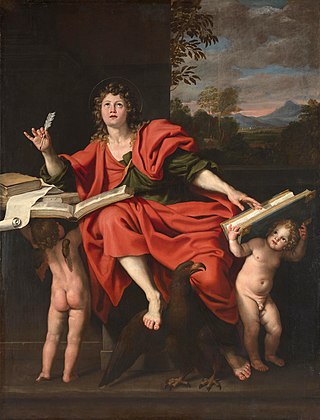
The Book of Revelation or Book of the Apocalypse is the final book of the New Testament. Written in Koine Greek, its title is derived from the first word of the text: apokalypsis, meaning 'unveiling' or 'revelation'. The Book of Revelation is the only apocalyptic book in the New Testament canon. It occupies a central place in Christian eschatology.
The Book of Joel is a Jewish prophetic text containing a series of "divine announcements". The first line attributes authorship to "Joel the son of Pethuel". It forms part of the Book of the twelve minor prophets or the Nevi'im ("Prophets") in the Hebrew Bible, and is a book in its own right in the Christian Old Testament. In the New Testament, his prophecy of the outpouring of God's Holy Spirit upon all people was notably quoted by Saint Peter in his Pentecost sermon.

Yahweh was an ancient Levantine deity, and national god of the Israelite kingdoms of Israel and Judah. Though no consensus exists regarding the deity's origins, scholars generally contend that Yahweh is associated with Seir, Edom, Paran and Teman, and later with Canaan. The origins of his worship reach at least to the early Iron Age, and likely to the Late Bronze Age, if not somewhat earlier.

The Four Horsemen of the Apocalypse are figures in the Book of Revelation in the New Testament of the Bible, a piece of apocalypse literature attributed to John of Patmos. Similar allusions are contained in the Old Testament books of Ezekiel and Zechariah, written about six centuries prior. Though the text only provides a name for the fourth horseman, subsequent commentary often identifies them as personifications of Conquest (Zelos), War (Martius), Famine (Limos), and Death.
The Olivet Discourse or Olivet prophecy is a biblical passage found in the Synoptic Gospels in Matthew 24 and 25, Mark 13, and Luke 21. It is also known as the Little Apocalypse because it includes the use of apocalyptic language, and it includes Jesus's warning to his followers that they will suffer tribulation and persecution before the ultimate triumph of the Kingdom of God. The Olivet discourse is the last of the Five Discourses of Matthew and occurs just before the narrative of Jesus's passion beginning with the anointing of Jesus.
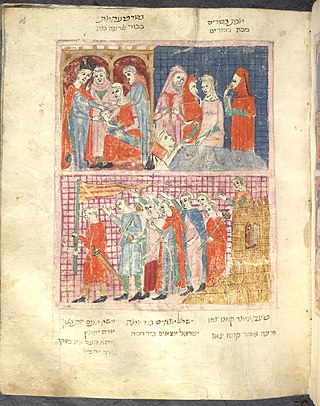
The Plagues of Egypt, in the account of the Book of Exodus, are ten disasters inflicted on biblical Egypt by the God of Israel (Yahweh) in order to convince the Pharaoh to emancipate the enslaved Israelites, each of them confronting Pharaoh and one of his Egyptian gods; they serve as "signs and marvels" given by God to answer Pharaoh's taunt that he does not know Yahweh: "The Egyptians shall know that I am the LORD". The Ten Plagues are recited during the Passover Seder.

Joel was an Israelite prophet, the second of the twelve minor prophets and according to the book itself the author of the Book of Joel. He is mentioned by name only once in the Hebrew Bible, in the introduction to that book, as the son of Pethuel. The name Joel combines the covenant name of God, YHWH, and El (god), and has been translated as "YHWH is God" or "one to whom YHWH is God," that is, a worshiper of YHWH. Scholars view Joel as having been completed in the Ptolemaic period due to its use of earlier texts and perspective on Yahweh and the nations.

"The Day of the LORD” is a biblical term and theme used in both the Hebrew Bible and the New Testament, as in "The sun shall be turned into darkness, and the moon into blood, before the great and the terrible day of the LORD come".

The Exodus is the founding myth of the Israelites whose narrative is spread over four of the five books of the Pentateuch.

Christ Clone Trilogy is a Christian science fiction trilogy by the American novelist James BeauSeigneur, dealing with the end of the world by presenting a fictionalized version of Christian eschatology.
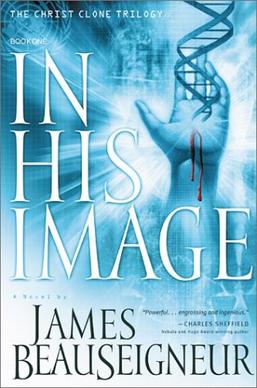
In His Image is a science fiction novel by American writer James BeauSeigneur, the first book in the Christ Clone Trilogy.
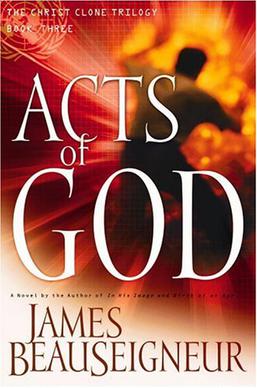
Acts of God is the concluding novel of the Christ Clone Trilogy, written by James BeauSeigneur. This book primarily chronicles the Bowl Judgements as foretold in the Book of Revelation, as well as the institution of Mark of the beast, and the growing persecution of the followers of God. Other biblical prophecies from the Book of Revelation and the Book of Daniel are depicted as well.

Answer to Job is a 1952 book by Carl Jung that addresses the significance of the Book of Job to the "divine drama" of Christianity. It argues that while he submitted to Yahweh's omnipotence, Job nevertheless proved to be more moral and conscious than God, who tormented him without justification under the influence of Satan. This scandal made it necessary for God to become united with man. Satan was banished from heaven and God incarnated as purely good, through a virgin birth, into the sinless redeemer Jesus Christ. Eventually, however, God will incarnate his evil side as well. For this to happen, the Holy Ghost left by Christ on earth has to enter "empirical", sinful human beings in whom the divine can be realized completely. Jung turns to the Book of Ezekiel, the Book of Enoch, and especially the Book of Revelation to consider how this may unfold. He suggests that the contemporary modern era, in which humanity possesses immense technological power, is significant to this second divine birth. He interprets the 1950 papal dogma of the Assumption of Mary as easing this transition towards completeness by re-emphasizing the feminine dimension of God.
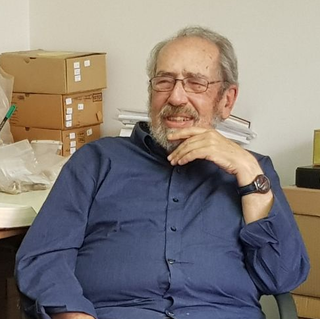
Gabriel Barkay is an Israeli archaeologist.
The House of Yahweh (HOY) is a religious group based in Eula, Texas. The assembly has been controversial and is referred to as a cult by former members.

Salvation history seeks to understand the personal redemptive activity of God within human history in order to effect his eternal saving intentions.
Second Temple Judaism is the Jewish religion as it developed during the Second Temple period, which began with the construction of the Second Temple around 516 BCE and ended with the Roman siege of Jerusalem in 70 CE.
The Prophecy is an American fantasy horror-thriller film franchise, which focuses on angels fighting each other to protect the survival of the human race on Earth. Produced by Dimension Films, the series was established in 1995 with the eponymous first installment, The Prophecy, which has since been followed by four direct-to-video sequels. In 2005, its latest sequel The Prophecy: Forsaken was released on DVD instead of VHS.













